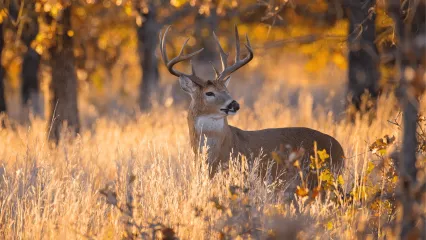
Contacts
Attention Hunters:
Chronic Wasting Disease has been detected near the area. A Selective Surveillance Area (SSA) has been established for Cimarron County.
Rita Blanca WMA covers 15,575 acres of southwestern Cimarron County in the Oklahoma panhandle. Located just south of Hwy. 64 (south of the town of Felt), Rita Blanca WMA is a shortgrass prairie.
Buffalo grasses predominate. Rita Blanca is scattered into 46 units covering 26 miles along the Oklahoma/Texas state line, (Cimarron/Dallam Co., Texas). The average annual precipitation for the area is about 18 inches.
From Boise City: There are many units scattered throughout the area, mostly south of U.S. Hwy 56 and west of U.S. Hwy 385 to the Texas border. Consult map for specific unit locations.
- Pheasant: Present in low numbers.
- Quail: Blue quail may be present in low numbers in some units.
- Deer: Mule deer may be present but in very low numbers.
- Antelope: Antelope present in fair number but are heavily sought after. Antelope is open to archery only.
- Rabbit: Both cottontails and jackrabbits are present with cottontails being more common.
- Furbearers: Coyotes present.
- Dove: Dove are usually present in good numbers during peak migration.
- Black-tailed Prairie Dog: Present on the WMA; no hunting of prairie dogs allowed.
- Bald Eagle: Eagles winter around Black Mesa State Park to the north.
Approximately 39 windmills to provide watering facilities for wildlife. Windmills are operated by Cibola National Forest as part of the prescribed grazing of cattle. Windmills may be turned off when no cattle are present. Management efforts focus on producing native wildlife foods such as ragweed and sunflower.
No designated camping areas are offered on the area.
Both lodging and restaurants are available in Clayton, NM and Boise City, OK. The Clayton Chamber of Commerce can be reached at (505) 374-9253. The Boise City Chamber of Commerce can be reached at (580) 544-3344.
A winter time trout fishery exists at Black Mesa State Park, about 30 miles north of the area. Contact Black Mesa State Park at (580) 426-2222 for further information.
Closed Seasons
Same As Statewide Seasons
Seasons w/ Special Restrictions
- Crow, Snipe, Woodcock, Rabbit, Squirrel
Closed during the first nine days of deer gun season.
- Deer Muzzleloader
Closed to antlerless hunting.
- Deer Gun
Open the first nine days only. Closed to antlerless hunting.
- Waterfowl, Sandhill Cranes, Pursuit with Hounds for Furbearers, Predator/Furbearer Calling
Closed during deer gun season.
- Pheasant
Closed during the first nine days of deer gun season. Hunting hours close at 4:30 p.m. daily.
- Turkey Fall Gun
Shotgun only.
- Trapping
Open to water sets, live box traps and enclosed trigger traps only through Jan 31. Open same as statewide Feb 1 through end of February.
- Turkey Spring, Youth Turkey Spring
One-tom limit; seasons combined. Hunting hours close at 7:00 p.m. daily.
- Quail
Closed during the first nine days of deer gun season. Hunting hours close at 4:30 p.m. daily. Closed to non-resident hunting February 1-15.
OHV (Off-Highway Vehicle) use is regulated by the U.S. Forest Service.
Camping is allowed in accordance with U.S. Forest Service regulations.
Cimarron County
Chamber of Commerce
PO BOx1027, Boise City, 73933
580-544-5344
ccc@ptsi.net
Oklahoma Tourism and Recreation Department
Post Office Box 52002
Oklahoma City, OK 73152-2002
(800) 652-6552 or (405) 521-2409
www.travelok.com
Controlled Hunts: Yet More Ways to Up Your Odds
Additional features continue to be added to the Wildlife Department’s controlled hunts program.
Cackling Geese Tracked in Central Flyway Study
Researchers are tracking cackling geese wintering in a five-state study area to learn more about their movements and habitat preferences.
Study Focused on Bats and Disease-causing Fungus
Bat surveys were conducted to learn more about Oklahoma’s bat communities and hundreds of bats were swabbed for the fungus that causes white-nose syndrome.


